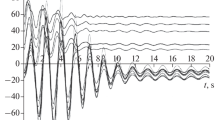Abstract
A new method of decomposition of linear electrical networks for calculating total power is presented. By an iterative procedure, on the basis of decomposition of the electrical network, the branches containing power sources (voltage and/or current) are selected first until the remaining network becomes passive. Then, one calculates the power dissipated by the decomposed networks supplied by the corresponding power sources. Total power dissipated by impedances of the starting networks is equal to the sum of powers dissipated by impedances of the decomposed networks, under the condition that all impedances Z of the network are either resistive \({\text{Im}}(Z)=0\) or reactive \({\text{Re}}(Z)=0\) or mutually equal.











Similar content being viewed by others
References
Charles A D and Ernest S K 2009 Basic circuit theory. India: McGraw-Hill Education Pvt Limited
Norman B and Theodore B 1981 Linear network theory: analysis, properties and synthesis. Beaverton, Oregon: Matrix Publishers Inc.
Bessonov L A 2016 Basic electrical engineering theory: electric circuits, 12th edn. Moskva: Yurayt (in Russian)
Ferreira L A F M 1992 Tellegen theorem and modelling of power systems-PV buses and nonlinear formulas. In: IEE Proceedings G-Circuits, Devices and Systems 139(1): 136–140. https://doi.org/10.1049/ip-g-2.1992.0023
Vittal V and Michel A N 1988 A variational principle for nonconservative power systems. Circuits, Systems and Signal Processing 7(3): 413–424
Rácz L Z 1973 A graph theory approach of decomposition techniques in power system calculation. Periodica Polytechnica EL 17/3: 217–224
Gupta H and Sharma J 1980 Decomposition techniques for circuit analysis. In: Proceedings of ESSCIRC: 6th European Solid State Circuits Conference, Grenoble, France, 22–25 September
Demov O D and Palamarchuk O P 2009 Decomposition of electrical networks at calculation reactive power compensation in them. Visnyk Natsionalnoho Universytetu “Lvivska politekhnika”. Elektroenerhetychni ta elektromekhanichni systemy (in Ukrainian), No. 637, p. 2427
Demov O D and Pivniuk Y Y 2017 Step-by-step calculation of reactive power compensation in electrical networks based on their decomposition. Tekhnichna Elektrodynamika 1: 81–86 (Jan/Feb)
Tomislav B Š 1995 A method of decomposition of power in linear electrical networks. In: Proceedings of the XXXIX ETRAN Conference (in Serbian), Zlatibor, 6–9.VI, pp. 319–322
Chen W K 1990 A general n-port network reciprocity theorem. IEEE Transactions on Education 33(4): 360–362
Penin A 2015 Analysis of electrical circuits with variable load regime parameters. Switzerland: Springer International Publishing AG.
Jovan Č M and Tomislav B Š 2015 A new reactive power definition based on the minimization of the load non-reactive currents. In: Proceedings of the 2015 12th Conference-Seminar of International School on Nonsinusoidal Currents and Compensation, Lagow, Poland, pp. 1–6. https://doi.org/10.1109/ISNCC.2015.7174683
Czarnecki L S 2015 Currents’ physical components (CPC) in four-wire systems with nonsinusoidal symmetrical voltage. Przeglad Elektrotechniczny 1(6): 50–55. https://doi.org/10.15199/48.2015.06.07
Tomislav B Š, Jovan Č M and Djurišic Ž R 2008 Optimal reactive compensators in power systems under asymmetrical and nonsinusoidal conditions. IEEE Transactions on Power Delivery 23(2): 974–984
Hanoch L A, Aleksandar M S and Sergio J C 2005 An orthogonal decomposition of apparent power to application to an industrial load. In: Proceedings of the Power Systems Computation Conference (PSCC), Liege, Belgium, August, Session 22, Paper 5, pp. 1–7
Acknowledgements
Author Tomislav B Šekara gratefully acknowledges support of the Ministry of Education, Science and Technological Development of the Republic of Serbia by Grant TR33020.
Author information
Authors and Affiliations
Corresponding author
Rights and permissions
About this article
Cite this article
Radulović, M., Šekara, T.B. & Lutovac, B. Decomposition of a class of linear electrical networks for calculation of total power. Sādhanā 43, 139 (2018). https://doi.org/10.1007/s12046-018-0911-1
Received:
Revised:
Accepted:
Published:
DOI: https://doi.org/10.1007/s12046-018-0911-1




